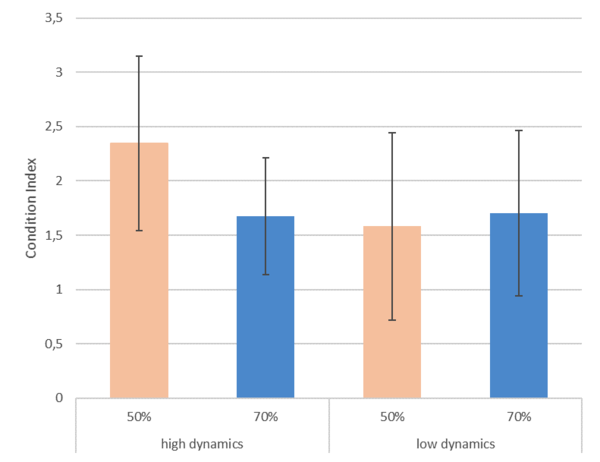| Regel 12: | Regel 12: | ||
|Paragraph number=1 |
|Paragraph number=1 |
||
|Paragraph language=Dutch-English |
|Paragraph language=Dutch-English |
||
| − | |Paragraph=No statistically significant results were found during the laboratory experiments, however, the results suggest that oyster growth was greatest in longer inundation time with higher organic:inorganic material in the water. In the field experiments growth and survival varied between treatments with no obvious optimal level of inundation or hydrodynamics that could be applied as a general observation. |
+ | |Paragraph=No statistically significant results were found during the laboratory experiments, however, the results suggest that oyster growth was greatest in longer inundation time with higher organic:inorganic material in the water. In the field experiments growth and survival varied between treatments with no obvious optimal level of inundation or hydrodynamics that could be applied as a general observation. |
| + |
At Schelphoek survival was highest in the low hydrodynamic area with 70% inundation time (average of 79% survival) and lowest in the low hydrodynamics and 50% inundation (average of 68%) while in the high hydrodynamics an average of 70% of oysters survived at both inundation times (Figure 1.). |
||
| − | [[File:Oysters on the dyke data collection.png|thumb|center|600px|Average survival at Schelphoek of oysters in ‘low’ and ‘high’ hydrodynamic locations and at 70% and 50% inundation time. {{Cite|resource=File:Oysters on the dyke.pdf |name= (Brink en Capelle 2017) }}.]] |
+ | [[File:Oysters on the dyke data collection.png|thumb|center|600px|Figure 1. Average survival at Schelphoek of oysters in ‘low’ and ‘high’ hydrodynamic locations and at 70% and 50% inundation time. {{Cite|resource=File:Oysters on the dyke.pdf |name= (Brink en Capelle 2017) }}.]] |
| − | [[File:Oyster on the dyke condition.png|thumb|center|600px|Figure |
+ | There was much variation in the condition index of the oysters from all four treatments at Schelphoek after 10 months in the field (Figure 2.). Although it appears that oysters experiencing 50% inundation and high water dynamics had the highest CI of all the treatments, the only statistically significant difference was that the 50% inundation with high dynamics had a higher CI than those in the low dynamics treatment. {{Cite|resource=File:Oysters on the dyke.pdf |name= (Brink en Capelle 2017) }}. |
| + | |||
| + | [[File:Oyster on the dyke condition.png|thumb|center|600px|Figure 2. Condition Index of the oysters from the four treatments at Schelphoek after 10 months in the field. {{Cite|resource=File:Oysters on the dyke.pdf |name= (Brink en Capelle 2017) }}.]] |
||
}} |
}} |
||
Versie van 4 okt 2017 om 16:22
| Bfn Data collection and data analysis | |
|---|---|
| Context | Bfn Building for Nature project |
| Decompositie type | IOR |
No statistically significant results were found during the laboratory experiments, however, the results suggest that oyster growth was greatest in longer inundation time with higher organic:inorganic material in the water. In the field experiments growth and survival varied between treatments with no obvious optimal level of inundation or hydrodynamics that could be applied as a general observation. At Schelphoek survival was highest in the low hydrodynamic area with 70% inundation time (average of 79% survival) and lowest in the low hydrodynamics and 50% inundation (average of 68%) while in the high hydrodynamics an average of 70% of oysters survived at both inundation times (Figure 1.).

There was much variation in the condition index of the oysters from all four treatments at Schelphoek after 10 months in the field (Figure 2.). Although it appears that oysters experiencing 50% inundation and high water dynamics had the highest CI of all the treatments, the only statistically significant difference was that the 50% inundation with high dynamics had a higher CI than those in the low dynamics treatment. (Van den Brink en Capelle 2017).

De View-Navigation (VN) pagina's.
De links naar andere pagina's.
| Produceert | Bfn Conclusion oyster cultivation on dykes |
|---|---|
| Consumeeert | |
| Onderdeel van | Bfn Oyster production on dykes |
| Instantie van | |
| Betreft |
De pagina's die linken naar deze pagina.
Dit element heeft geen subelementen.
| Komt van | Type | Connectie type | Conditie | Waarde | Opmerkingen |
|---|---|---|---|---|---|
| Bfn Design and installation | Connects | seq |






